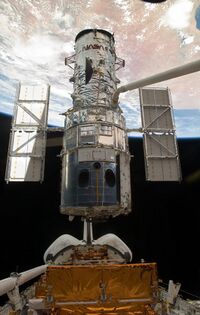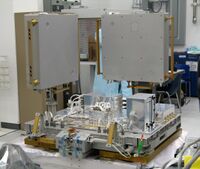Astronomy:SpaceCube
From HandWiki
SpaceCube is a family of high-performance reconfigurable systems designed[when?] for spaceflight applications requiring on-board processing. The SpaceCube was developed by engineers at the NASA Goddard Space Flight Center.[1] The SpaceCube 1.0 system is based on Xilinx's Virtex-4 commercial FPGAs. The debut mission of the SpaceCube 1.0, Hubble Servicing Mission 4, was the first time Xilinx's Virtex-4 FPGAs flew in space.[2]
Missions
- Hubble Servicing Mission 4: The SpaceCube was the brains of the Relative Navigation Sensors autonomous docking experiment that was intended to run in parallel with the astronaut controlled docking of the Hubble Space Telescope.[3] RNS met its stated goals.[4]
- MISSE-7: The SpaceCube was attached to the outside of the ISS during an EVA on Space Shuttle Mission STS-129 (Nov 2009). It provides an on-orbit test platform for demonstrating innovative radiation hardened by software techniques. It is mounted on the NRL's MISSE7 experiment which is attach to an ExPRESS Logistics Carrier.[5][6]
Family overview
- SpaceCube 1.0: Based on Xilinx's Virtex-4 commercial FPGAs.
- SpaceCube 1.5: Intermediate version of SpaceCube 2.0. Based on Xilinx's Virtex-5 commercial FPGAs. Scheduled to fly on sounding rocket flight in the fall of 2010.[7]
- SpaceCube 2.0: Currently[when?] under development with over $1 million in funding.[7] The SpaceCube 2.0 system is based around Xilinx's new radiation-hardened Virtex-5 FPGA.[7][8][needs update]
Awards
NASA's Goddard Space Flight Center SpaceCube team earned an honorable mention for the 2009 "IRAD Innovator of the Year" award.[9]
On-board science data processing achievements
- Synthetic Aperture Radar (SAR) results:
References
- ↑ Office of the Chief Technologist (2006). "NASA Goddard Space Flight Center FY 2006 Internal Research and Development Program". NASA Goddard Space Flight Center. http://gsfctechnology.gsfc.nasa.gov/2006_AR_V6_FINAL_low.pdf.
- ↑ "Xilinx December 2008 Newsletter". Xilinx. 2008. http://newsletter.xilinx.com/emails/12-2008.html.
- ↑ Office of the Chief Technologist (2008). "SpaceCube to Debut in Flight Demonstration: Hybrid Computer to Fly on Hubble Servicing Mission". NASA Goddard Space Flight Center. http://gsfctechnology.gsfc.nasa.gov/SpaceCube.htm.
- ↑ Flight Results of the HST SM4 Relative Navigation Sensor System
- ↑ ISS Program Scientist's Office (2009). "Materials International Space Station Experiment - 7 (MISSE-7)". NASA. Archived from the original on 2008-12-10. https://web.archive.org/web/20081210181244/http://www.nasa.gov/mission_pages/station/science/experiments/MISSE-7.html.
- ↑ Astronauts Install SpaceCube on International Space Station
- ↑ 7.0 7.1 7.2 Office of the Chief Technologist (2009). "Goddard Tech Trends Spring 2009". Goddard Space Flight Center. http://gsfctechnology.gsfc.nasa.gov/newsletter/Spring_2009_TT_lowres.pdf.
- ↑ "Rad-Hard Virtex-5". Defense Update. http://defense-update.com/products/v/Virtex-5.htm.
- ↑ "Goddard 2009 IRAD Innovator of the Year award". Goddard Space Flight Center. 2009. http://gsfctechnology.gsfc.nasa.gov/2009InnOfYear.htm.
- ↑ 10.0 10.1 "SpaceCube On-Board SAR Data Processing Results". Goddard Space Flight Center. 2010. http://www.facebook.com/album.php?aid=282219&id=141354918547.
External links
- PowerPC405 MIPS Study
- Goddard Space Flight Center technologies site
- SpaceCube on Facebook
- A pose and position measurement system for the Hubble Space Telescope servicing mission
- Relative Navigation
- Summer 2008 Goddard Tech Trends
- MAPLD 2009 RNS SpaceCube
- MAPLD 2009 SpaceCube Activities
- RHBD Xilinx Virtex-5
- Heavy ion SEE test of Xilinx Virtex4 XC4VFX60 FPGA
- SpaceCube Virtex-4 FPGA qualification methodology
- Spring 2009 Goddard News Tech Transfer
- Xilinx XCell Journal Customer Innovation Issue
- Media
- SpaceCube Photo Gallery on Flickr
- MISSE-7 SpaceCube development team
- SpaceCube in Atlantis Shuttle bay(The SpaceCube is mounted on the MISSE-7 ExPA on ELC-2 on the bottom right.)
- SpaceCube mounted to MISSE7's ExPA(The SpaceCube is the smaller box with several connectors on top)
- Naval Research Lab's MISSE-7 Press Release[yes|permanent dead link|dead link}}]
 |



